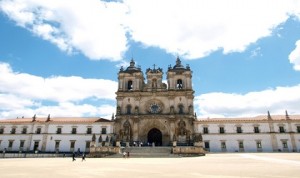 The Monastery of Santa Maria de Alcobaça, also known as Real Abadia de Santa Maria de Alcobaça or Alcobaça Monastery, is located in Alcobaça and it is the first Gothic work built in Portugal.
The Monastery of Santa Maria de Alcobaça, also known as Real Abadia de Santa Maria de Alcobaça or Alcobaça Monastery, is located in Alcobaça and it is the first Gothic work built in Portugal.
Founded in 1153, by gift of the King Afonso Henriques to Bernardo de Claraval, a monk of the Cistercian Order, the current abbey only began to be built from 1178, by the same religious order.
Having been one of the first monastic foundations of the Cistercian Order in Portugal, the Alcobaça Monastery became the principal house of the respective religious order, due to a continued policy of royal protection, initiated by the King D. Afonso Henriques.
The Alcobaça Abbey occupied a strategic importance to the Christian Portuguese expansion, in direction to the south, especially after the conquest of the cities of Santarem and Lisboa in 1147. Then the protection of court (Lands with immunity to the taxes and real justice) was delivered to the militia of the Temple Order, exempting the Cistercian order, the most possible of the military assaults of the Moors.
The date of the construction of the Abbey, is involved in a very significant “strategic.” Four years after its date of construction, was made the canonization of São Bernard, having the Abbey, being one of the first Cistercian abbeys to be built with the respective objective.
The medieval dependencies still preserved, makes the Alcobaça Monastery a unique set, at worldwide level, to which, compounded the later edifications, of the XIV to XVIII centuries as an important witness of the evolution of Portuguese architecture.
Over times, the importance of the Alcobaça Monastery grew in cultural, religious and ideological terms, having been substantially expanded and enriched with the successive royal donations.
In 1308, the King D. Dinis ordered the construction of the Cloister of Silence or D. Dinis, added a floor later in the reign of the King D. Manuel I (1495-1521), who had also built the designated Manueline Sacristy works commissioned by the Spanish architect João de Castilho.
From the Cardinal Abbot D. Henrique (1567), it began the big space changes in the Abbey, with the construction of the Abbey Palace at the North extreme of the North Wing and of the Cloister of the Cardinal, followed, in the 17 TH Century, the Inn, the original Hall of the Kings and the Novitiate.
Presently, the Monastery it is constituted by a church next to the sacristy and at North, by followed three cloisters, being each one surrounded in its entirety, by two floors, as well, as by a wing at the South. The Cloisters, including the oldest, presents also two floors. It also integrates the Monastery, chapels, halls, the Royal Pantheon, the Library, the old Abbey Palace and adjacent areas.
The Church, as was common practice initiated by the bedside, contains three ships at the same time, the crossing of two aisles and ambulatory, forming a set of unique characteristics by its simplicity, grandeur and austerity.
Of unusual beauty, is the Reliquary and Death Altar of São Bernardo, from the end of the 17th Century, built on clay, as well the great kitchen of the 18th century. The Hall of Tombs, in a neo-Gothic style, keeps the graves of several queens and princes. In the transept of the church are the tombs of D. Pedro and D. Ines de Castro, two of the most beautiful works of the tomb century Portuguese architecture of the 14th century.
In 1834, in the following of the extinction of the religious orders in Portugal, by Mouzinho da Silveira, the monks were forced to leave the monastery.
The Alcobaça Monastery, is classified as a National Monument through the decrees DG No. 14, 01/10/1907; 1DG, No. 136, 16.6.1910 and as special protection area DG (Series II), No. 190 of 16 -08-1957.
Since 1989, the Abbey of Alcobaça, is recognized as World Heritage by UNESCO, being one of the most important Cistercian abbeys in Europe, taking into account its condition and its architecture, the symbol of Cister.
In 2007, the Alcobaça Monastery, received a classification of “7 Wonders of Portugal” by the organization with the same name, which had as objective to elect the seven most important monuments of the Portuguese architectural heritage.







